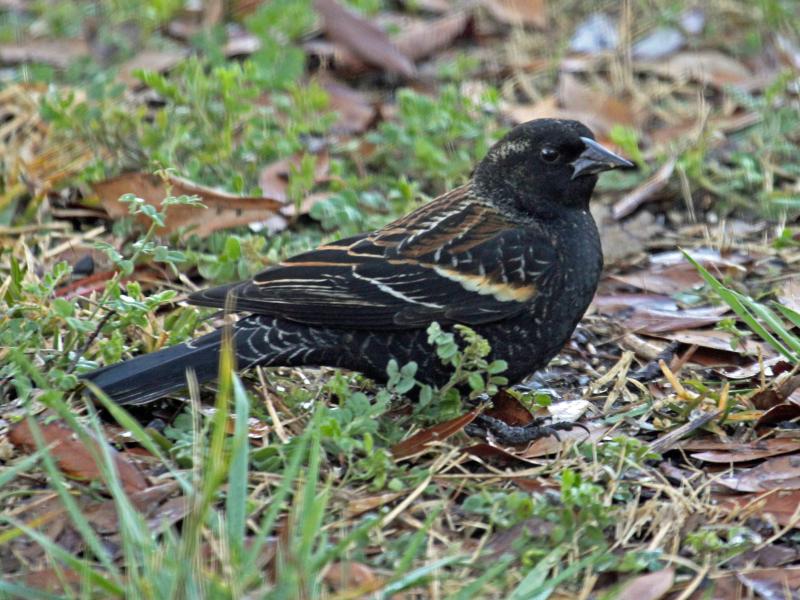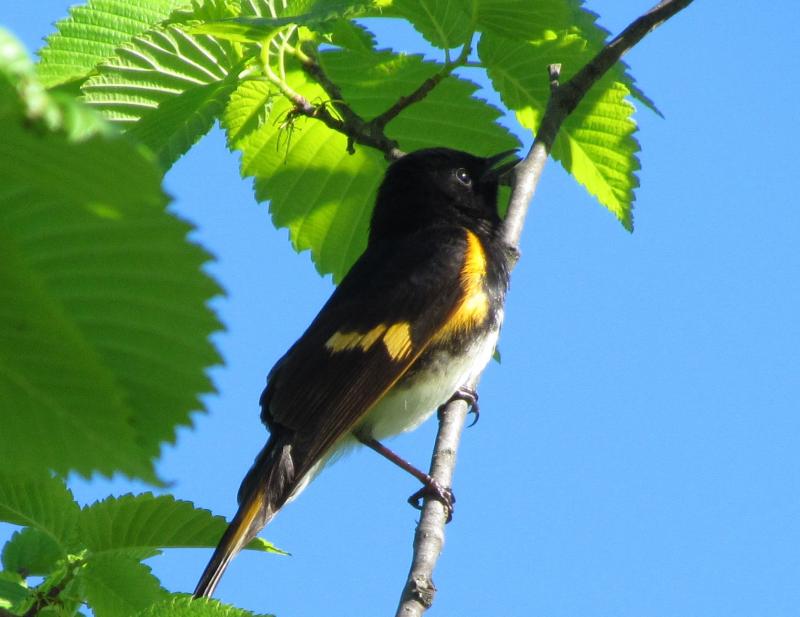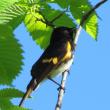A Blackbird or a Starling?
 An immature male red-winged blackbird, like this one, can be confusing as it seems to combine features of the male plumage and the female plumage. Photo by DickDaniels http://theworldbirds.org/ courtesy of Wiki Commons
An immature male red-winged blackbird, like this one, can be confusing as it seems to combine features of the male plumage and the female plumage. Photo by DickDaniels http://theworldbirds.org/ courtesy of Wiki Commons
 An adult male American redstart after his first year is a dramatic display of black and orange. Courtesy of Jeff Wells
An adult male American redstart after his first year is a dramatic display of black and orange. Courtesy of Jeff Wells
 An immature male red-winged blackbird, like this one, can be confusing as it seems to combine features of the male plumage and the female plumage. Photo by DickDaniels http://theworldbirds.org/ courtesy of Wiki Commons
An immature male red-winged blackbird, like this one, can be confusing as it seems to combine features of the male plumage and the female plumage. Photo by DickDaniels http://theworldbirds.org/ courtesy of Wiki Commons
 An adult male American redstart after his first year is a dramatic display of black and orange. Courtesy of Jeff Wells
An adult male American redstart after his first year is a dramatic display of black and orange. Courtesy of Jeff Wells
Brother Andrew texted us the other day with a question about identifying an odd-looking blackbird. Could it be a starling or a red-winged blackbird, he asked? He went on to ponder as to whether a young red-winged blackbird would look more like a starling. We gave him a standard answer about looking for the yellow bill of the starling as compared to the dark one of the red-winged blackbird.
You might wonder why we didn’t mention the fact that a red-winged blackbird has a red and yellow patch on each wing while a starling doesn’t. We didn’t mention that because we were guessing that he must have seen a female red-winged blackbird. The females in that species are brown-streaked and have no wing patches, so a simple differentiating feature from a starling, which looks vaguely similar, is the yellow bill of the starling rather than the dark bill of the female red-winged blackbird.
A few days later, Brother Andrew sent us a photo from under his feeder of one of the birds whose identities he was pondering. It was a red-winged blackbird with some yellow visible on the top of the folded wing, indicating it was a male, yet it was also rather brown and streaky like a female. It is not unusual in many songbird species for some males in their first spring to show some female plumage features and some male features. Young songbirds of both sexes usually look more or less like the females in the fall. In some species, the adult males molt back into a female-like plumage in fall as well. Presumably, this typically more well-camouflaged plumage will keep them safer from predators during fall migration and early winter.
Over the course of the winter non-breeding season, some males replace all the female-type plumage with the more conspicuous male breeding season plumage. Males in the first year, however, may only replace some of that female-type plumage, resulting in birds with combinations of features that can make them more challenging to identify.
Sometimes it just results in odd-looking birds.
Male indigo buntings in their first spring are well-known for sometimes looking like the work of a bad artist, with patches of blue chaotically arranged on a brownish background. But they still are driven to sing like most male indigo buntings do in spring. How well they do in finding a mate that first year is open to question!
There are a few species in which apparently all first-year males have a different plumage in their first spring. One is the tiny but common warbler, the American redstart. The fully adult males are jet black on the head, wings and tail with bold orange markings on the wings and tail and on the sides of the upper breast. First-year males, on the other hand, look similar to the females, with gray head, back, wings, and tail and yellow or orange-yellow patches in the tail, wings, and sides of the upper breast but almost always with some patches of black coming in around the head.
Orchard oriole, another bird in the blackbird family like the red-winged blackbird, is another in which males in their first year show a plumage pattern more similar to the greenish-yellow female rather than the brick-red and black adult male. The first-year male adds in the black throat to the otherwise female-type plumage. Many of the relatively few orchard orioles that birders find here in Maine in spring are usually these black-throated first-year males.
Thanks, Brother Andrew, for looking so closely at those birds under your feeder and sharing your questions with us so we could share the story of those unusual-looking first-year birds with readers of this column!
Jeffrey V. Wells, Ph.D., is a Fellow of the Cornell Lab of Ornithology and Vice President of Boreal Conservation for National Audubon. Dr. Wells is one of the nation's leading bird experts and conservation biologists and author of the “Birder’s Conservation Handbook.” His grandfather, the late John Chase, was a columnist for the Boothbay Register for many years. Allison Childs Wells, formerly of the Cornell Lab of Ornithology, is a senior director at the Natural Resources Council of Maine, a nonprofit membership organization working statewide to protect the nature of Maine. Both are widely published natural history writers and are the authors of the popular books, “Maine’s Favorite Birds” (Tilbury House) and “Birds of Aruba, Bonaire, and Curaçao: A Site and Field Guide,” (Cornell University Press).
























